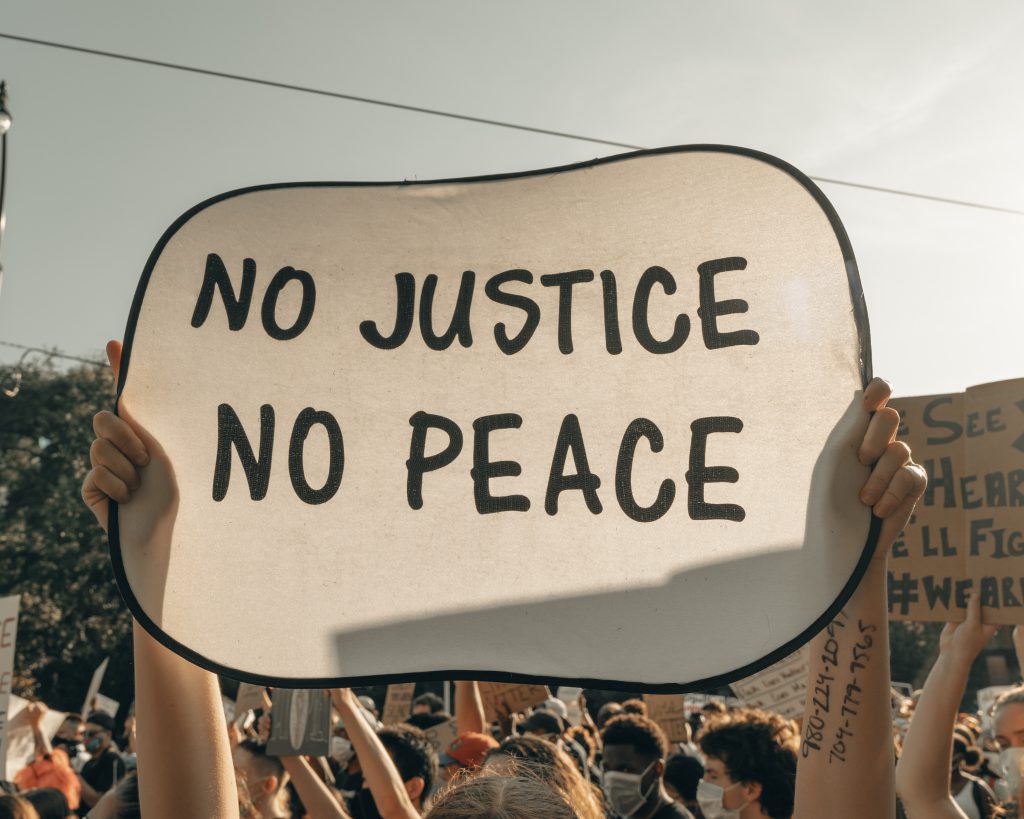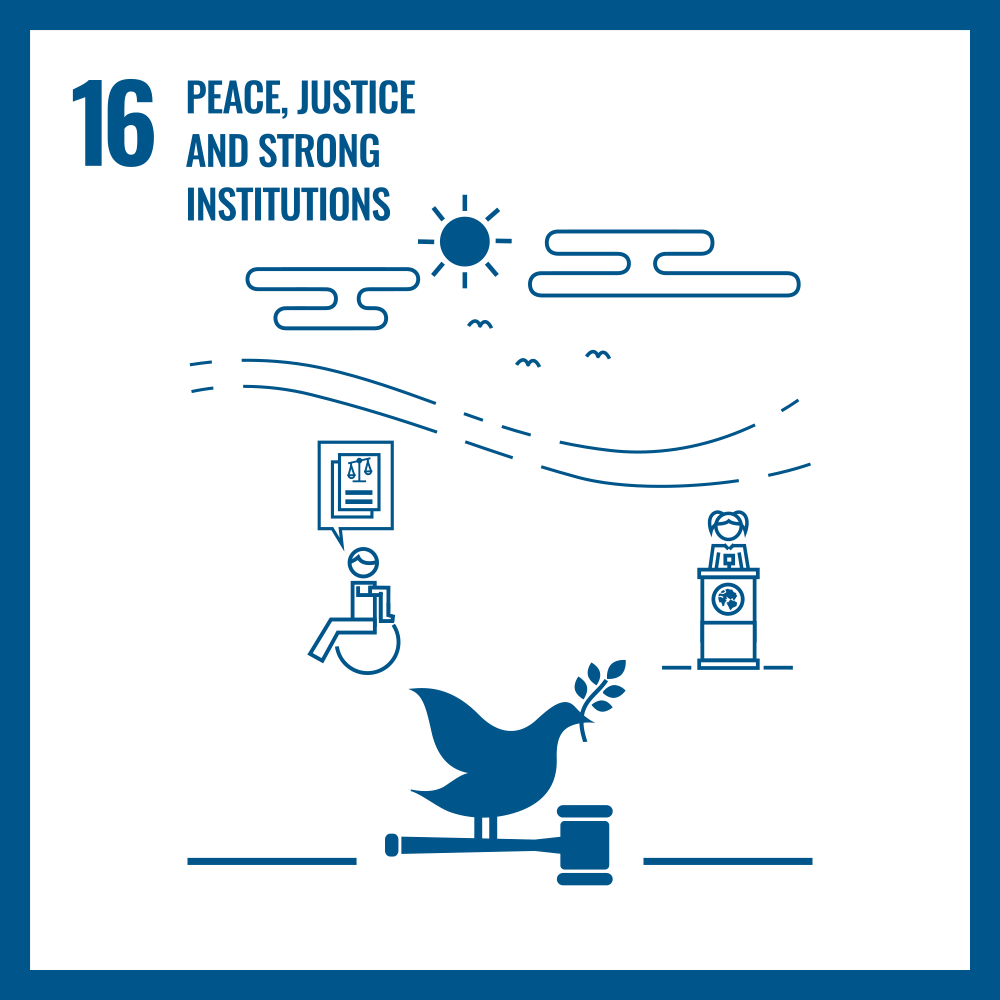I felt enthusiastic and hopeful when the 2030 Agenda for Sustainable Development and its seventeen Sustainable Development Goals (SDGs) were announced in 2015 to succeed the Millennium Development Goals (MDGs). Working as an international civil servant then on issues that pertain to human rights and democracy, I was becoming increasingly jaded the longer I worked on development. Thus, those positive feelings, particularly over the inclusion of SDG 16 among the goals, were welcome (and, yes, rather rare).
Among others, SDG 16 tackles the interaction between justice and peace

Source: Photo by Clay Banks on Unsplash
Seeing poverty, corruption (that exacerbates poverty) and the suffering that average citizens experience (due to both poverty and corruption), I was starting to question if there was light at the end of the (development) tunnel. Agenda 2030 and the SDGs are thus an important shift to how we do development work. They are comprehensive, ambitious, and forward-looking. Finally, the nations of the world are seriously coming together to secure our future. Now, we could all focus, roll up our sleeves, and get on with the work.
However, after going through each of the SDGs, I realised that while each had a clear focus on an outstanding issue of concern that it would like to address, like hunger (SDG 2), health and well-being (SDG 3) and climate change (SDG 13), I found that this was not the case for SDG 16. Unlike the other goals, it appears to be a multitude of issues that were cramped into one goal: peace, justice and strong institutions. The image I was getting was that of a can of overflowing sardines packed to the brim.
Are the concepts in SDG 16 like a jam-packed can of sardines?

Source: Photo by S O C I A L . C U T on Unsplash
In short, SDG 16 aims to “promote just, peaceful and inclusive societies”. Outright, this aim is really referring to three complex concepts (or even groups of concepts): (1) (access to) justice (and the rule of law), (2) peace (and security) and (3) inclusion (not leaving anyone behind).
Yes, these concepts are all interrelated and perhaps reinforcing (i.e. they need to be achieved simultaneously to actually occur), but could they be aptly and adequately tackled by the nations of the world under just one goal? Taken one by one, they are not at all simple issues and could each be separate goals in themselves.
Cynically, I had the impression that SDG 16 was a late addition, an afterthought when they were drawing up all the goals in New York. These concepts were not in the MDGs and were even considered a serious omission. Their omission was framed as one of the reasons for the MDGs shortcomings, thereby, limiting UN Member States’ ability to fulfil the MDG targets.
Thus, to rectify that, they are now part of the SDGs, albeit an add-on. There may not have been ample time at the UN to discuss and deliberate on these key concepts, unpack them and shed light on the underlying causes of the problems in realising each of them.
In the end, and on a positive note, we should be thankful that we have a goal that points out, in a sense, how our societies should be: peaceful, safe, equitable and just. SDG 16 highlights that our problems, and all the other issues the remaining SDGs are trying to address, do not exist or operate in a vacuum. They are influenced by the kind of societies we live in, including many different pull and push factors. SDG 16 is not just a goal in itself but also an enabler of all the other SDGs. Without it, it is not feasible to achieve all the other goals.
However, on the negative side, we obtained in SDG 16 a rather “fat” goal. It is so loaded that it is more aspirational and utopic than one that can be achieved in good time, i.e., by 2030.
What is SDG 16?

Source: UN Department of Global Communications
Written out in full, SDG 16 aims to “promote peaceful and inclusive societies for sustainable development, provide access to justice for all and build effective, accountable and inclusive institutions at all levels.” It has 12 global targets and 24 associated indicators. The targets range from those that pertain to the individual rights-holder, SDG Target 16.9: “By 2030, provide legal identity for all, including birth registration”, to those that pertain to the global governance, SDG Target 16.8: “Broaden and strengthen the participation of developing countries in the institutions of global governance”.
To me, this implies two things. Firstly, to get to know (and help realise) this goal, you and I, as rights holders, need to unpack it ourselves and understand what each of the concepts therein pertain to and what is covered. Secondly, linked to my first point: there is no one agency or actor that can fulfil all these goals. It requires a myriad of actors at all levels to coordinate and work together to address parts of it that will hopefully contribute to the fulfilment of the overall goal.
Rather than crying over spilled milk, however, I deem that advances in media and information communications technology (ICT) could actually help us navigate and understand SDG 16. After all, a better understanding of the issues is already part of achieving the goal. Thus, in this introductory post, I would like to share with you my top 3 websites for SDG 16, all of which are run by international organisations that are working towards achieving this goal, including through the use of ICT. They are as follows.
| My Top 3 Picks for SDG 16 Resources | ||
| UNDP Oslo Governance Centre | International Development Law Organisation (IDLO) | International Institute for Democracy and Electoral Assistance (International IDEA) |
| The first is run by the UNDP Oslo Governance Centre, particularly its programme on Just and Inclusive Institutions. The Centre produces research, data and insights to ensure informed policy responses that uphold human rights and deliver more just and inclusive governance services. Moreover, it runs the SDG 16 Hub, a one stop portal (with a newsletter), intended for anyone interested in getting knowledge and information on SDG16 | The second is the International Development Law Organisation (IDLO), an intergovernmental organisation devoted to the promotion of the rule of law to advance peace and sustainable development. IDLO explains how the rule of law helps fulfill SDG 16 and the site produces stories of how this is put into practice, particularly in the countries (most of which post-conflict and fragile) that they operate in. It also co-organises together with the UN Department of Economic and Social Affairs, the annual SDG 16 Conference, which brings together all relevant actors – government and non-governmental – to review SDG 16 implementation with a view to learn and make strides towards its realisation. | Last but not least is the website of the International Institute for Democracy and Electoral Assistance (International IDEA). A intergovernmental democracy organisation, the site features databases, tools and knowledge products that rights holders and institutions could use to help them achieve SDG 16. Through stories and good examples, albeit with a bias towards democracy, they help one understand how peaceful and inclusive societies can lead to better lives for all citizens and advance sustainable development. |
In my forthcoming interactive post, which will come out on 11 October on the occasion of the International Day of the Girl Child, I will write more about SDG 16 but in particular, I will focus on the nexus of SDG 16 and SDG 5 (Gender Equality). In it, I will endeavour to tackle just how much of an enabler is SDG 16 for SDG 5, in particular for the girl child.
Do tell me if you agree with my observation that SDG 16 is a fat and aspirational goal (and in that regard difficult to achieve)? Do you have any sites that you would like to add to my list to better understand and realise SDG 16?

